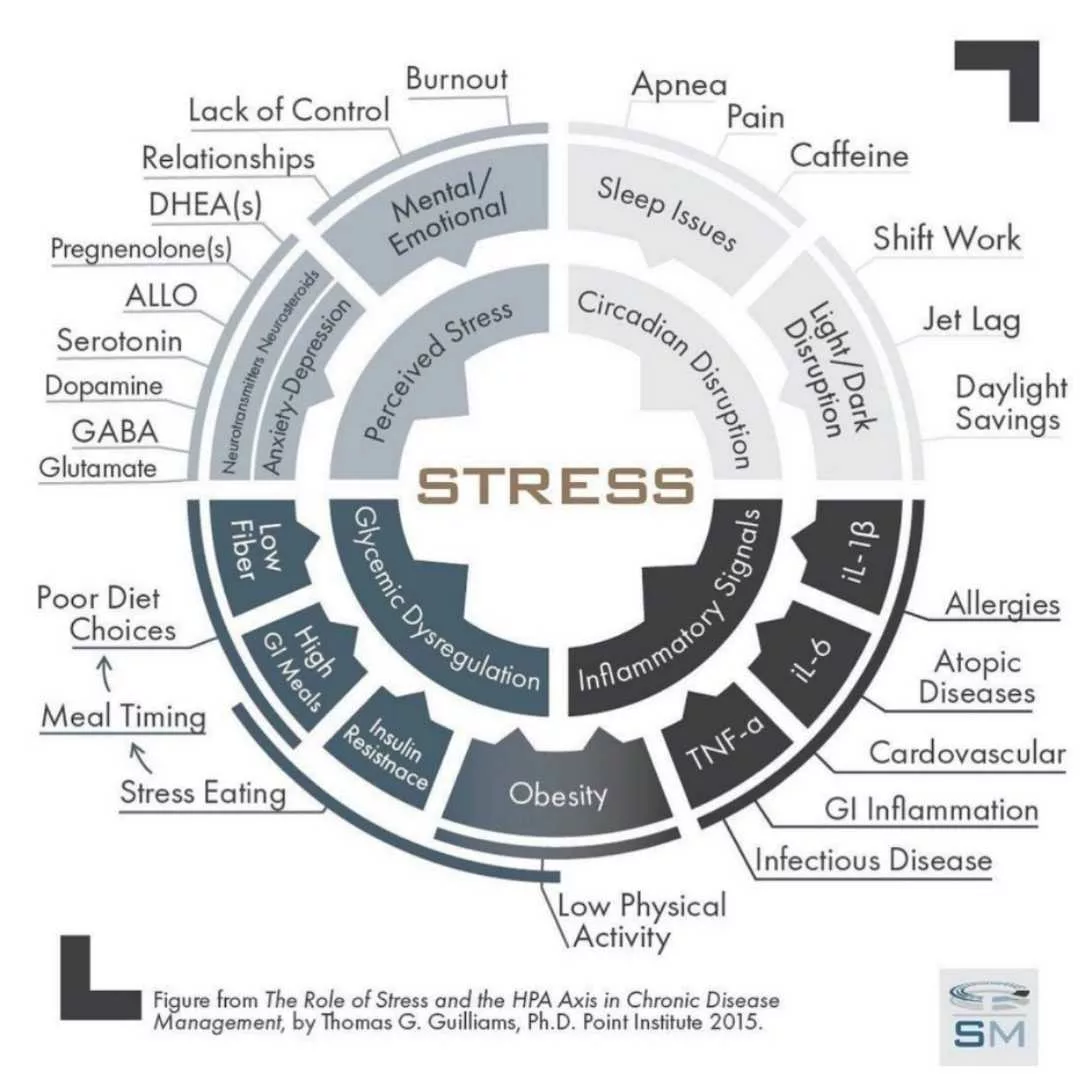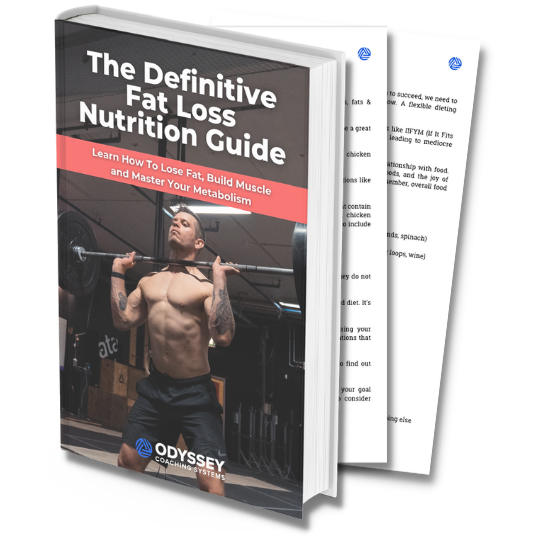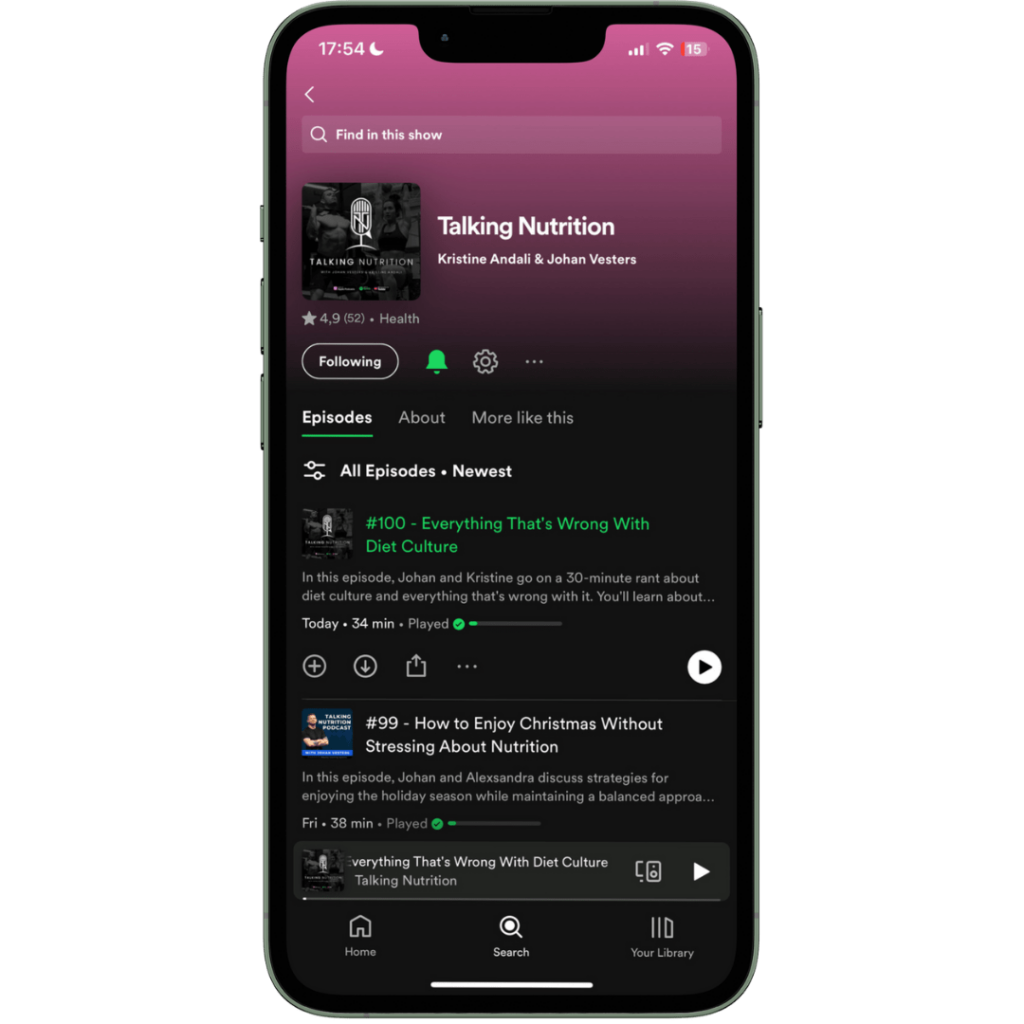Main Take-Aways
1. Stress can be good or bad. There are many forms of stress, but to the body they’re all one and the same.
2. The sum of all your life stressors together is called the allostatic load, and there’s only so much you can handle.
3. Managing stress is not just about trying to remove all stress. It’s more about keeping your allostatic load within the sweet spot, while balancing the different states of your nervous system.
Looking for ways to relieve stress? Managing stress may just be THE one thing you can work on to take your results to the next level. But what does it even mean to ‘manage your stress’?
Health and fitness is really a Stress vs Adaptation game. There’s a stimulus (a stressor) that disrupts the norm (homeostasis, a state of balance). This will in turn push your body to adapt for better or worse, depending on how well you recover.
Some temporary/acute, or ‘good’ stress can improve your immune system (1) and push your body to get better, stronger, faster, and more resilient. While chronic, or ‘bad’, stress seems to do the opposite and can lead to chronic inflammation (2), insulin resistance (3), sickness, faster aging, injury, digestive issues and more.
Does managing stress sound like an impossible task to you? Good news!
It’s easier than you’d think. In this article you will learn 20 effective ways to relieve stress. Please make sure to read this whole article front-to-back, because this is going to be one of the more in-depth ones.
Different types of stress
You’re probably familiar with modern day stress related to work, studies, relationships, finances… Though there are many other types of stress, which can be good or bad depending on their type and/or context.
The different types of stress include:
- Perceived stress:
Including anxiety, depression, mental/emotional stress. - Circadian disruption:
Including light/dark disruption and sleep issues. - Inflammatory signals:
Including infectious disease, allergies, cardiovascular, inflammation, obesity. - Glycemic dysregulation:
Including insulin resistance, obesity, poor diet, low physical activity.

Managing stress: what about exercise?
Exercise is something everyone can benefit from. It keeps you healthy and strong, helps avoid metabolic slowdown as you age and it even seems to have some amazing mental benefits like reducing anxiety and depression (4). But does it induce or relieve stress?
While exercise can be a great outlet for many and you do want to exercise for the above mentioned reasons (and more), there’s a catch: Also exercise is a form of stress to the body. This means that managing stress includes adjusting your training when necessary.
So what does that ‘stress vs recovery game’ look like in the case of performance and muscle building? Here’s how it works.
You expose a muscle to stress by performing an exercise/lifting a certain amount of weight. In order to deal with that stressor better next time. In the right conditions, your body will then adapt by building bigger and stronger muscles, so that next time that stressor comes around you’re able to deal with it much better (i.e. the weight will be easier to lift).
To progress even further, you then want to increase the amount of weight, sets or reps to challenge your muscles again. This concept is called progressive overload.
But! It’s not as simple as constantly sending your body that signal of “Hey we need to get bigger, better, faster, stronger”. You will only get better if you give your body a chance to recover.
That means managing stress and getting enough (quality) food, rest, plenty of sleep, adjusting training load and taking actual rest days. Depending on your goals, schedule, and overall stress levels I recommend exercising about 3-5 times a week for most people. 4-6 times a week for a pro, or serious enthusiast who knows how to recover well. Although rest days don’t sound very sexy, they’re an essential part of recovery and should not be neglected if you want to progress.
Allostatic Load – How Much Stress Can You Handle?
- Very little to no stress will keep you in your comfort zone, where it’s safe but where growth won’t happen.
- Too much stress, for too long, will begin to work against you.
- The just-right amount of stress can help you grow physically, physiologically, and mentally.
‘Fight/Flight’ vs ‘Rest/Digest’ – Understanding Your Nervous System
Ok, just one more concept you need to understand before I’ll show you exactly how to relieve stress. Managing stress really comes down to balancing the two different states of your nervous system. While technology continues to evolve, our bodies never really get an update. We’re still wired the same way our ancestors were during cavemen times.
Imagine yourself going back in time, as we get into the different states of your nervous system.
Sympathetic Nervous System
The stress response, also called ‘Fight or Flight’. This is where you fight the bear, or run away from it to survive. Cortisol and adrenaline (6) are high, making you feel alert, ready and focused.
Your body breaks down tissue to mobilize energy to help you deal with the stressor, as it halts important processes like digestion, tissue repair, sex hormone production, and more
While there’s only a tiny chance that you have to fight or run away from a bear these days, your body does have the same exact response when you’re facing an intense workout, stress at work, in traffic, a nasty message on social media, or any other modern day stressors.
Parasympathetic Nervous System
Once the threat has passed, you get to go back to your cave and your body returns to the recovery state, also called ‘Rest and Digest’. Your body is now in a much safer environment to take care of important processes like digesting food, rebuilding tissue (including muscle), and producing important hormones like your sex hormones.
While the fight/flight state is more ‘catabolic’ in nature, meaning your body breaks down tissue, the rest/digest state is considered ‘anabolic’, meaning your body (re)builds.
Let’s take this back to a modern day gym scenario. Your workout at the gym is fighting the bear. It’s the stressor, or stimulus, that when you allow for enough recovery time in your cave, should lead you to become bigger and stronger to fight the bear (do the workout) again next time it comes around.
20 proven methods To Relieve Stress
Managing stress is not just about trying to remove all stress. It’s more about keeping your allostatic load within that sweet spot, while balancing the different states of your nervous system.
But enough fancy words for today, look at it this way. Just how you can’t keep using your phone without charging it, you can only push your body so far until it says “That’s enough!”.
You probably have a good idea of what drains your batteries, and I can imagine that it can be quite a bit sometimes. So let’s try and do more of the things that recharge your batteries. The following list includes my top 20 recommended methods that you can use to relieve stress and spend more time in a parasympathetic state:
- Going for a walk (7), preferably in nature. Walking in urban areas still seems to be beneficial, though you’ll likely get an additional benefit from walking in a green space (8) like a park.
- Taking (more) rest days.
- Reading.
- Meditating.
- Breath work.
- Spending time in nature.
- Journaling/affirmations.
- Listening or playing music.
- Practicing your favorite hobbies.
- Sleeping enough. (Click here for the best sleep habits).
- Getting a massage, or rather any kind of human touch (9).
- Lowering caffeine use (10).
- Minimizing mobile phone use altogether (11,12).
- Spending less time on social media (13). Tip: mute or unfollow pages that bother you or make you feel insecure (through comparison).
- Drinking Green tea (14).
- Listening to binaural beats (15,16).
- Supplementing with Ashwaghanda.
- Supplementing with Rhodiola Rosea.
- Supplementing with L-theanine.
- Lavender supplementation or essential oils.
*I highly recommend first addressing your behavior and lifestyle. Supplements probably won’t do the trick if your habits aren’t taken care of first.
**Before supplementation, do your own research (Examine.com is a great resource) and talk to your doctor first.
Managing stress – Putting it into practice
Congrats! You should now have a good understanding of the different types of stress and how stress isn’t always bad, depending on the type of stress and how long-lived it is.
I encourage you to now take action, to take what you’ve learned and apply it to your daily life. So go ahead and do some inventory, address your allostatic load and how much you do on the recovery side of things.
To get better, the sexy stuff like doing intense workouts needs to be compensated for by doing plenty of the boring stuff, like sleeping 7-8 hours a night, eating & drinking enough water and taking a moment to yourself every now and then.
Look into these 20 ways to relieve stress, pick your favorite, and just start by trying one of them. Grab your free habit tracker and set yourself a goal of taking 10 minutes out of your day to recharge your batteries, every day.
Stress is the signal that can push you to become better, or worse. And your results will only be as good as the amount of time you spend being in a parasympathetic state.
- Dhabhar, Firdaus S. “Effects of stress on immune function: the good, the bad, and the beautiful.” Immunologic research vol. 58,2-3 (2014): 193-210. doi:10.1007/s12026-014-8517-0
- Liu, Yun-Zi et al. “Inflammation: The Common Pathway of Stress-Related Diseases.” Frontiers in human neuroscience vol. 11 316. 20 Jun. 2017, doi:10.3389/fnhum.2017.00316
- Guszkowska, Monika. “Wpływ ćwiczeń fizycznych na poziom leku i depresji oraz stany nastroju” [Effects of exercise on anxiety, depression and mood]. Psychiatria polska vol. 38,4 (2004): 611-20.
- Ranabir, Salam, and K Reetu. “Stress and hormones.” Indian journal of endocrinology and metabolism vol. 15,1 (2011): 18-22. doi:10.4103/2230-8210.77573
- Guidi, Jenny et al. “Allostatic Load and Its Impact on Health: A Systematic Review.” Psychotherapy and psychosomatics vol. 90,1 (2021): 11-27. doi:10.1159/000510696
- Yan, Yu-Xiang et al. “Investigation of the Relationship Between Chronic Stress and Insulin Resistance in a Chinese Population.” Journal of epidemiology vol. 26,7 (2016): 355-60. doi:10.2188/jea.JE20150183
- Roe, Jenny, and Peter Aspinall. “The restorative benefits of walking in urban and rural settings in adults with good and poor mental health.” Health & place vol. 17,1 (2011): 103-13. doi:10.1016/j.healthplace.2010.09.003
- Aspinall, Peter et al. “The urban brain: analysing outdoor physical activity with mobile EEG.” British journal of sports medicine vol. 49,4 (2015): 272-6. doi:10.1136/bjsports-2012-091877
- Eckstein, Monika et al. “Calming Effects of Touch in Human, Animal, and Robotic Interaction-Scientific State-of-the-Art and Technical Advances.” Frontiers in psychiatry vol. 11 555058. 4 Nov. 2020, doi:10.3389/fpsyt.2020.555058
- Lovallo, William R et al. “Cortisol responses to mental stress, exercise, and meals following caffeine intake in men and women.” Pharmacology, biochemistry, and behavior vol. 83,3 (2006): 441-7. doi:10.1016/j.pbb.2006.03.005
- Andrew Lepp, Jacob E. Barkley, Aryn C. Karpinski “The relationship between cell phone use, academic performance, anxiety, and Satisfaction with Life in college students” Computers in Human Behavior vol. 31 (2014) Pages 343-350, ISSN 0747-5632, doi:10.1016/j.chb.2013.10.049.
- Thomée, S., Härenstam, A. & Hagberg, M. Mobile phone use and stress, sleep disturbances, and symptoms of depression among young adults – a prospective cohort study. BMC Public Health 11, 66 (2011), doi:10.1186/1471-2458-11-66
- Karim, Fazida et al. “Social Media Use and Its Connection to Mental Health: A Systematic Review.” Cureus vol. 12,6 e8627. 15 Jun. 2020, doi:10.7759/cureus.8627
- Hozawa, Atsushi et al. “Green tea consumption is associated with lower psychological distress in a general population: the Ohsaki Cohort 2006 Study.” The American journal of clinical nutrition vol. 90,5 (2009): 1390-6. doi:10.3945/ajcn.2009.28214
- Phneah, Swee Wu, and Humaira Nisar. “EEG-based alpha neurofeedback training for mood enhancement.” Australasian physical & engineering sciences in medicine vol. 40,2 (2017): 325-336. doi:10.1007/s13246-017-0538-2
- Padmanabhan, R et al. “A prospective, randomised, controlled study examining binaural beat audio and pre-operative anxiety in patients undergoing general anaesthesia for day case surgery.” Anaesthesia vol. 60,9 (2005): 874-7. doi:10.1111/j.1365-2044.2005.04287.x






